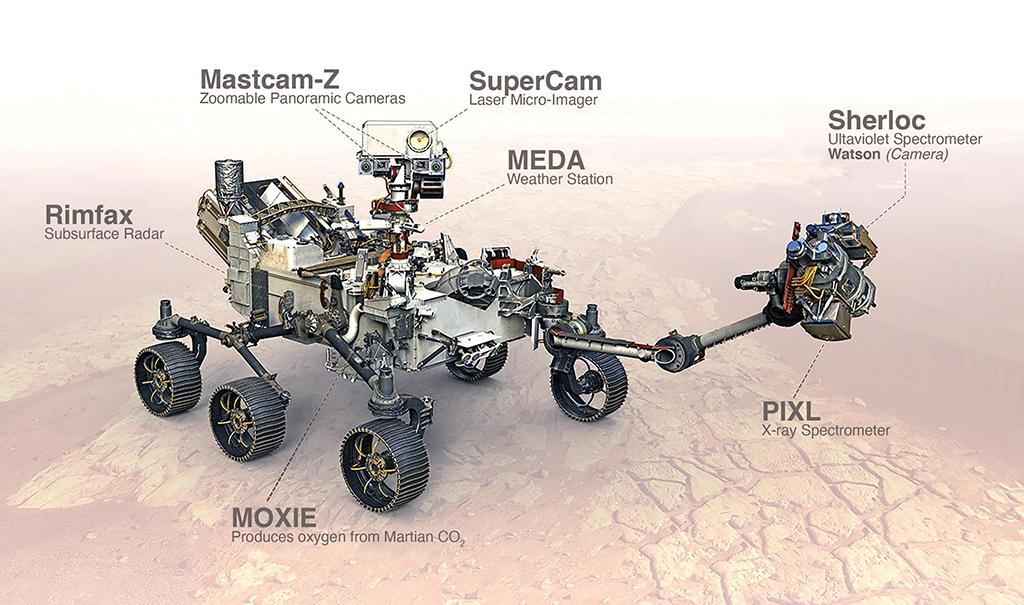
The most important thing about Jezero Crater, the landing site for NASA’s upcoming Mars 2020 Perseverance rover mission, is that billions of years ago it was Jezero Lake, a deep body of water replenished by rain, ice or snow that may have teemed with microbial life.
The lake is long gone—a victim of Mars’ extreme climate change—but microfossils may be locked inside Jezero’s spectacularly preserved river delta, where the rover’s mission will begin, and other sites such as potential ancient hot springs on the rim of the 28-mi.-wide (45-km) crater.
- Rover expected to land on Feb. 18, 2021
- Ancient river delta first target for study
Perseverance is scheduled to launch from Cape Canaveral AFS between July 30 and mid-August aboard a United Launch Alliance Atlas V rocket. Like the Mars Science Laboratory Curiosity rover, which arrived at Gale Crater in August 2012, Perseverance will make a parachute, retrorocket and sky crane descent, touching down on the flat floor of Jezero Crater on Feb. 18, 2021.
Engineers at the Jet Propulsion Laboratory (JPL) in Pasadena, California, added two new technologies for Perseverance’s entry, descent and landing.
One is Range Trigger, which will be used to time the parachute’s deployment based on navigation position, resulting in a smaller landing target. The other is Terrain Relative Navigation, an autopilot that can determine the spacecraft’s position over the Martian surface by comparing images from a downward-pointing camera on the rover with stored images taken by Mars orbiters. It then quickly selects the best reachable, safe landing site and commands the spacecraft’s descent stage to fly to that point. The system can change the rover’s touchdown point by up to 2,000 ft.
“In the very last stages of descent, Mars 2020 has the ability to steer away from any hazards. We didn’t have that,” says Curiosity project scientist Ashwin Vasavada.
Perseverance, NASA’s fifth Mars rover, closely resembles Curiosity, whose mission was to determine if the planet most like Earth in the Solar System ever had the ingredients for life.
“NASA has had a very deliberate, strategic Mars exploration program, with a combination of orbiters and landers and rovers,” says Vasavada. “The rovers, in particular, were sent to follow up on the things we saw from orbit and some of the big questions we’ve always had about the presence of liquid water on ancient Mars and the possibility of life.”

Following the 1997 Mars Pathfinder mission, the Spirit and Opportunity rovers were dispatched to confirm the present of past liquid water. Those rovers, which operated from 2004 to 2018, led to a broader quest by the Curiosity rover to assess other factors for habitability, such as the presence of carbon and other organic molecules.
“At the time, we weren’t confident enough to kind of repeat Viking and send something directly to go discover life somewhere,” says Vasavada. “We wanted to learn more about what makes an environment habitable, and if any of those environments ever existed on Mars.”
Curiosity, whose mission is ongoing, has found carbon and minerals altered through long-lasting water, setting the stage for Perseverance, the first life-detection mission since the 1976-80 Viking missions.
Curiosity’s landing site features a 3.4-mi.-high mountain, called Mount Sharp, rising from the floor of Gale Crater. “We’ve found really no break in the habitability of Mars . . . as we’ve climbed layer by layer up through Mount Sharp,” says Vasavada.
Curiosity has covered more than 1,300 ft. of stratigraphy, representing hundreds of thousands to millions of years of Mars’ history. “There is basically a continual record of lake sediments. That tells us there was persistent liquid water in ancient Mars, and that’s about the best-case scenario in terms of what we thought might be on Mount Sharp,” says Vasavada.
“We’re very optimistic to take the next step to look directly for signs of ancient life,” he says.

Extraordinary Claims
Astronomer and astrobiologist Carl Sagan once famously said “extraordinary claims require extraordinary evidence,” a mantra NASA intends to fully embrace in its first attempt to find life on Mars since the Viking missions. So while Perseverance will analyze rocks and soils in situ for potential chemical and geomorphic fingerprints of life, it will pack up 30-38 of the best samples for a return trip to Earth on a later mission.
“Our bar is high for the identification of a sign of life on another planet—as it should be,” says Katie Stack Morgan, Perseverance deputy project scientist. “But I think we also have to open our minds to the possibilities of what life could look like on another planet.”
Scientists will be scanning for patterns, textures and substances that cannot be readily explained without the influence of life. “Every time we see something on the surface of Mars that gets us asking those questions, we go through the list of possibilities,” says Morgan.
“If we get to the point where we are really struggling to explain a phenomenon or something that we see with abiotic processes, that’s when we start to say, ‘I think this could be a potential biosignature,’” she adds. “Our job is to identify things that are worthy of additional study on Earth with the full arsenal of analytical capabilities that we have here in our laboratories.”
Though scientists have been studying about 125 meteorites that came from Mars, they have longed to analyze pristine Martian rocks and soils. “Samples from Mars have the potential to profoundly change our understanding of the origin, evolution and distribution of life on Earth and elsewhere in the Solar System,” says Lori Glaze, NASA Planetary Science Division director.
“Even now, NASA continues to study Moon samples brought back by the Apollo program more than 50 years ago,” she adds. “We expect samples of the red planet to provide new knowledge for decades to come as we study them with state-of-the-art laboratory equipment we couldn’t possibly take to Mars right now.”
'Welcome to Jezero'
Jezero Crater is located at 18.4 deg. N. Lat., 77.7 deg. E. Long. in the Nili Fossae region of Mars, straddling the area between the planet’s heavily cratered southern highlands and the flatter regions of the north.
Perseverance’s landing site on the crater’s flat floor is just east of a dramatic, fan-shaped ancient river delta that orbital data shows is replete with clays. Deltas form when rivers enter open bodies of water and deposit rocks, sand and potentially organic carbon in layers.
Jezero Crater once held a lake filled to a depth of up to 820 ft. by at least two river systems stemming from the Nili Fossae region. The lake was about the size of Lake Tahoe in the U.S. Sierra Nevada mountain range.
“An ancient lake is a fantastic place to pursue our goal of looking for possible Martian life,” says project scientist Ken Farley. “On Earth, lakes are filled with living creatures, and evidence of that life is often preserved in the mud and sand deposited on the bottom of the lake. So we use the rovers’ instruments to explore the rocks in the ancient lake bed.”
At some point, Jezero Lake breached its northeast rim and water flowed out, creating an open lake system with both inlet and outlet streams.
Jezero Crater, located on the inner rim of one of the largest and oldest impact basins on the surface of Mars, also contains some of the most ancient rocks in the Solar System, 3.5-4 billion years old, as well as a record of diverse geologic processes, including volcanism, impact cratering and properties associated with surface and subsurface water, which reveals how the planet evolved over time.
It also sports carbonate minerals around the crater’s inner rim. Carbonates can form in shallow lakes, another potential site for life.

“Part of the reason we picked Jezero Crater as the landing site was because it has such a well-understood environment that we could see and understand from orbital images alone,” says Morgan. “We know we have a delta, we know we had a lake in Jezero Crater, and we know this crater is perched on the rim of a giant impact basin. . . . That really helps us plan and plot out the course of our sampling exploration.
“We think that Jezero was home to a variety of different potential habitable environments,” she adds. “We don’t know for sure what biosignatures on Mars are going to look like, but we can look to our own Earth rock record to give us an example of what we might expect to find.”
For example, a 3.4-billion-year-old rock from Australia has been found to contain stromatolites, which is a fossilized microbial mat built layer by layer in shallow water.
“If you look at that rock you wouldn’t know for sure that it was a potential biosignature. But when you couple the textures as well as the chemical composition, the mineralogy and the distribution of organic carbon, you can start to build a case that rock could only have formed under the influence of life,” says Morgan.
“This is exactly the type of thing that we do here on Earth to make a case for biosignatures in our own rock records. And for the very first time . . . we can do that on the surface of Mars,” she adds.
In addition to caching samples for return to Earth, a multinational, multimission campaign planned for 2026-32, Perseverance will address some overarching science questions, such as how the surface and climate of Mars evolved over time and how rocky planets form and differentiate.
Perseverance is outfitted with a payload of seven instruments, including radar to study the subsurface and chemical-mapping instruments attached to the end of the rover’s robot arm.
“Curiosity has the ability to detect organic carbon, and it has detected organic carbon. But we haven’t been able to necessarily link the presence of the organics . . . to particular textures or patterns that we see in the rock that we think could have been left behind by life,” says Morgan. “It’s the connection of the textures and the composition that allow us to make a compelling case for a biosignature. The instruments on Perseverance allow us to do that really for the first time on the surface of Mars.”
The Mars 2020 mission also includes two technology demonstrations: a small helicopter, which will attempt the first aerial flight on another planet, and an experiment to convert carbon dioxide pulled from Mars’ atmosphere into oxygen. The test could lead to instruments to support human missions to Mars, providing air for breathing and propellant for fuel.
After Perseverance explores the ancient river delta, it will attempt to visit the shoreline of the ancient lake and then on to the crater’s rim. “Jezero Crater formed when a large object collided with Mars, excavating rocks from deep in the Martian crust,” says Farley. “Those rocks would have been hot shortly after the impact. . . . Deposits from any hot springs would be another target in our search for possible ancient life on Mars.”
NASA has invested approximately $2.4 billion to build and launch the Mars 2020 Perseverance mission. Operating costs during its two-year primary mission are about $300 million.
Editor's note: This story was updated to correct the headline.



Comments